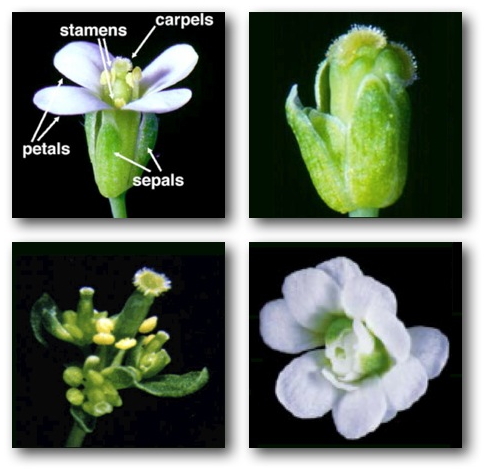 Team leader
Team leader
 Address
Address
Laboratoire Physiologie Cellulaire & Végétale
CEA-Grenoble
17 avenue des Martyrs
38 054 Grenoble cedex 9
France
 Members
GUILLOTIN Audrey
Members
GUILLOTIN Audrey, CNRS Study Engineer,
Audrey.Guillotin[@]cea.frHUGOUVIEUX Véronique, CEA Researcher,
Veronique.Hugouvieux[@]cea.fr
Le HIR Sarah, CEA Researcher,
Sarah.Lehir[@]cea.fr
HUTIN Stéphanie, Postdoc,
Stephanie.Hutin[@]cea.fr
JANEAU Aline, PhD Student,
Aline.Janeau[@]cea.fr
MIRONOVA Aleksandra, PhD Student,
Aleksandra.Mironova[@]cea.fr
PEREZ Mélissa, CEA Technician,
Melissa.Perez[@]cea.fr
ZUBIETA Chloe, CNRS Research Director,
Chloe.Zubieta[@]cea.fr
 Research thema
The astonishing diversity of all higher organisms relies on the evolutionary adaptation of developmental pathways present in basal phyla. Changes in developmental control genes, and the transcription factors (TFs) they encode, are at the advent of this new functionality. The MADS-box genes are an example of a family of developmental control genes, present in all eukaryotes, which have dramatically diversified during evolution and have undergone a particularly large lineage expansion in plants. Diversification of plant MADS TF function has been achieved by adding oligomerization domains to the basic DNA-binding machinery, allowing the precise control of a plethora of distinct developmental processes. In order to understand MADS TF function in plant development, we use a combination of structural biology, biophysical and genetic techniques.
Research thema
The astonishing diversity of all higher organisms relies on the evolutionary adaptation of developmental pathways present in basal phyla. Changes in developmental control genes, and the transcription factors (TFs) they encode, are at the advent of this new functionality. The MADS-box genes are an example of a family of developmental control genes, present in all eukaryotes, which have dramatically diversified during evolution and have undergone a particularly large lineage expansion in plants. Diversification of plant MADS TF function has been achieved by adding oligomerization domains to the basic DNA-binding machinery, allowing the precise control of a plethora of distinct developmental processes. In order to understand MADS TF function in plant development, we use a combination of structural biology, biophysical and genetic techniques.
Our current focus is the A-E class MADS-box genes and their role in flowering and floral organ morphogenesis. The overlapping expression patterns of the A-E class genes determine the correct formation of all floral organs - sepals, petals, stamen and carpel (Figure 1). Forward and reverse genetic studies have demonstrated that changes in the MADS genes lead to striking floral phenotypes (Figure 2) including the complete conversion of all floral organs to leaves. How this occurs at the molecular level is largely unknown. Current models postulate that the assembly of organ-specific tetrameric MADS complexes are necessary for floral organ development (Figure 3). These complexes are able to bind two DNA sites in the regulatory regions of target genes, causing a DNA loop resulting in target gene expression or repression and thus determine developmental fate (Figure 4). In order to integrate observed floral phenotypes with atomic and molecular level mechanisms, we combine
in vitro biophysical studies (protein crystallography, NMR, AFM) of the MADS TFs with
in planta genetic experiments.
|
Figure 1. Schematic diagram of the ABCDE model and floral organ development.
The overlapping expression patterns of the MADS-box genes (A-E) determine the identity of the floral organs. For example, the A and E class give rise to sepals and the combination of the A, B, and E class give rise to petals. |

|
Figure 2. Wild type and MADS mutants of
Arabidopsis thaliana.
Mutations in different MADS genes leads to striking floral phenotypes (from top left clockwise, wild type, ap3, ap1, ag). |
|
Figure 3. Composite structure of the DNA binding and oligomerization domains of the MADS TF, SEPALLATA 3 (SEP3).
The crystal structure of the SEP3 tetramer is shown in blue and green and the MADS DNA-binding domain of the human protein MEF2 is shown in gray. |
|
Figure 4. Atomic force microscopy studies of protein-DNA complexes.
A. DNA binding domain of SEPALLATA 3 in complex with a 1kb DNA from the promotor of AP3. The DNA is traced and the height of the DNA and protein measured.
B. Height in nm of DNA and protein as per A.
C. The specific binding of the protein can be confirmed based on the length of the DNA and the position of the CArG box DNA binding site. |